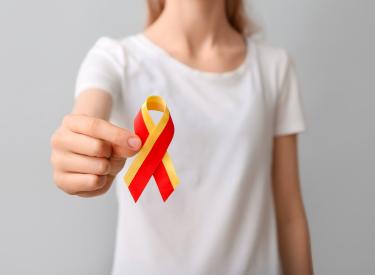
OB/GYN Shares Non-Opioid Options After Surgery
May is Women’s Health Month, a time to both celebrate women and to shine a light on the health issues that specifically affect them.
One area that is often overlooked? Women are disproportionately impacted by exposure to opioids. A recent report found that women ages 40-59 are prescribed more opioids than any other age group and receive twice as many opioid prescriptions as their male counterparts, putting them at increased risk for opioid dependence and addiction. While there are effective non-opioid options available to help manage pain following common women’s health procedures (e.g., C-sections, breast reconstruction, etc.) research shows that patients are often unaware and don’t discuss these options with their doctor. In fact, a survey found that 84% of women have concerns about being prescribed or taking opioids, but 67% still took them to manage pain after surgery.
Dr. Cynthia English, an OB/GYN in Texas, is passionate about providing optimal care and innovative options for her patients – including non-opioid options. This Women’s Health Month Dr. English is empowering women to be advocates for their own health and sharing her innovative approach to help reduce the need for opioids and get patients back to their daily routines quickly after common women’s health procedures.
Managing your patients’ pain following a C-section or other women’s health procedure is an integral part of your practice. What motivated you to adjust your approach to pain relief for women?
Women are undergoing surgeries every day. For example, almost 1.3 million pregnant women have their babies by C-section in the U.S. each year. Other common procedures include hysterectomy, breast reconstruction and joint replacements, including surgeries on the knee and hip. While men go through some of these surgeries as well, it is important to look at the impact on each gender specifically.
For example, I was disappointed to find that many of my female patients, particularly those who had C-sections, were experiencing opioid-related side effects that affected their ability to connect with their baby after birth. Many of my patients were drowsy, nauseous, and constipated from the opioids used during and after surgery. To help provide a more positive recovery experience, I began researching non-opioid options that could be used during C-sections and other women’s health procedures to manage my patients’ pain without these side effects and other downstream consequences including addiction or dependence.
What types of non-opioid pain management options do you use? And what are the benefits?
I utilize a long-acting numbing medication injected during surgery to help manage my patients’ pain after the procedure. This non-opioid option can provide relief for the first few days after surgery when pain is often the worst.
Since I began using non-opioid options as part of my pain management protocol, I have noticed my patients are having a much better recovery experience. For example, my C-section patients are up and moving in about six hours, eating real food, and are engaged with their newborn immediately. Further, about one-third of my patients are completely opioid-free, and we have seen an approximately 70% reduction in opioid prescribing overall. Patients are getting home sooner, reporting less pain, and having a better recovery overall, ultimately allowing them to experience those precious early days with their newborn. Non-opioid options have really helped revolutionize my patient care.
Despite these options, opioid overprescribing is still a serious issue in the surgical setting. What impact does the overprescribing of opioids after surgery have on women?
Research has found that women are 40% more likely than men to become newly persistent users of opioids after surgery, meaning they were still taking their opioids three to six months after their procedure. Women are also prescribed about 15% more opioids than men to manage pain after surgery, which can put them at increased risk for addiction or dependence. Armed with this knowledge, I am passionate about providing my female patients with alternatives to help minimize their exposure to opioids.
What should women know about pain management and recovery following women’s health procedures?
Women, including expecting moms, are typically familiar with details about their surgery like recovery time and options for labor, but do not consider how their pain will be managed or know that they can ask about options other than opioids. In fact, a recent survey titled, On the Rebound: What to Expect After Surgery found that women address several topics with doctors prior to surgery, but only 26% discuss non-opioid options to manage pain.
I want to empower my patients to be advocates for their own health and ask questions about their options, including opioid alternatives, to manage pain after surgery. Part of my job as an OB/GYN is to educate people about safe, effective pain management options that can help them recover quickly, manage pain, and reduce or eliminate the need for opioids. Pain is different for everyone, and it is important to find the option that works best for each patient and their specific needs.
What advice do you have for patients who aren’t sure how to discuss their pain management options with their doctor?
I believe strongly in patients having an open dialogue with their doctors to ensure all options are on the table, this way they can make decisions that are aligned with their individual needs. If a doctor doesn’t bring up pain management and non-opioid options during pre-surgery discussions, patients should feel confident to bring up the topic themselves. I encourage patients to seek out information and develop a treatment plan with their provider that better fits their recovery goals.
For anyone who may be preparing for surgery, there are helpful discussion guides available to facilitate these conversations. These resources provide an overview on what topics to discuss ranging from how pain is typically tolerated to how a caregiver should plan to support the patient during recovery.
As a mother, wife, and daughter I feel privileged that my job is to take care of other women. Women are often juggling many roles and responsibilities, and we put pressure on ourselves to recover and get back to our daily routines quickly. Discussing non-opioid options to manage pain after surgery can help us achieve those goals.




